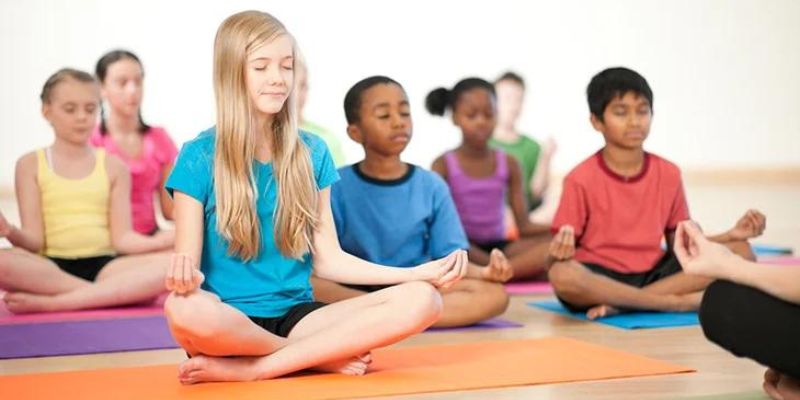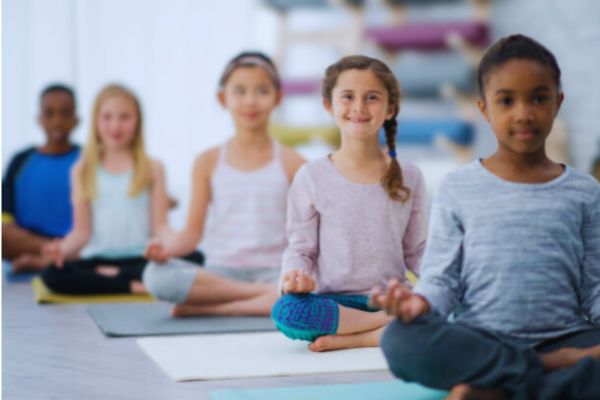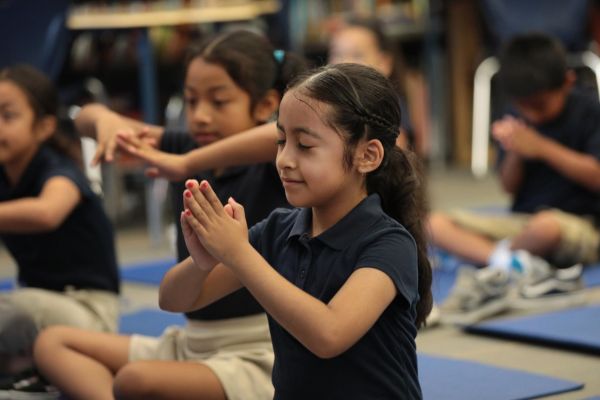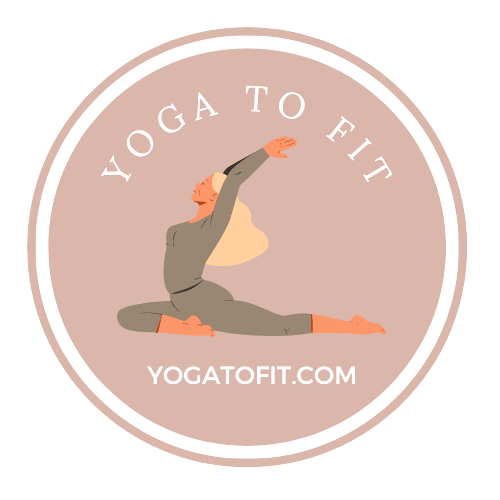Introducing Yoga to Kids in a School Classroom

School hours are sometimes hard for many kids as they include high amounts of school work, extended time sitting, and social pressures that can cause anxiety and stress in the children. To help lighten the mood and eliminate stress from the students, introducing yoga to kids in a school classroom can be a great idea. As we all know, yoga practice majorly focuses on physical postures, breathing techniques, and mindfulness and all these activities offer tons of benefits that support children’s overall well-being and development. Also, yoga can be a fun activity for kids in the school.
By including yoga in a daily routine and in the curriculum at school, teachers and other educators can help kids learn and understand emotional intelligence and can have fun by doing something different other than studies. In this article, we will learn about introducing yoga to help kids in a classroom, and some practical tips for how to add yoga sessions into kids’ school hours.
Benefits of Introducing Yoga to Kids in a School Classroom
If yoga is taught in the correct manner and with proper techniques, it can be really beneficial for kids at school. Introducing Yoga to kids in a school classeoom allows children to be conscious about their bodies, minds, and emotions. It also involves lots of fun for kids. Let’s understand the benefits of introducing yoga to kids in a school classroom:

1. Physical Benefits
- Yoga poses are simple and fun ways for kids to move and develop awareness from an early age.
- Many poses help kids develop flexibility, strength, and balance for their bodies.
- Balancing yoga poses can enhance kids’ posture, coordination, and core strength.
- Regular yoga practice can contribute to better body control and increased energy levels.
2. Emotional Regulation
- Introducing Yoga to kids in a school classroom encourages kids to explore and express their feelings wherever they feel safe.
- Breathing exercises and relaxation techniques help kids learn to handle stress and anxiety more effectively.
- Trying new poses with the aim of improvement helps kids build flexibility and courage.
3. Improved Concentration and Focus
- The mindfulness aspect of yoga teaches children to be present, active, and fully engaged in every moment.
- Learning new poses by watching a teacher helps improve focus and mind-body connection in kids.
- Mindfulness activities in yoga and meditation are easy as compared to classwork and also help kids increase their focus on schoolwork as well.
4. Enhanced Self-esteem and Confidence
- Yoga is a non-competitive practice that celebrates individual progress and growth.
- As kids master new poses or improve their techniques, they gain self-esteem and confidence, with a positive self-image in school.
5. Cultivation of Empathy and Compassion
- By introducing Yoga to kids in a school classroom, kids will start practicing with partners and in groups. This is how children learn to work together and support one another.
- While working on their own poses and postures and celebrating growth, they will start to see and recognize achievements in others as well with the feeling of empathy.
Tips to Introduce Yoga to Kids in a School Classroom
Here are some tips to remember before introducing yoga to kids in a school classroom. Have a look:

1. Create a Welcoming Space or Ambience
If you don’t have an extra space in your school classroom, but, if you have a Calm Down Corner or Take a Break space, then this space can be modified into a little yoga space for kids. You can create an environment for practicing yoga by putting a yoga mat or a mirror, some yoga books, a few fidget toys, and yoga pose cards so that kids can practice on their own in that space.
2. Choose a Time of Day
Try to choose a perfect time to introduce yoga to kids in a school classroom as yoga session in a proper manner and keep it constant every day so that the kids become active at that particular time and set up their minds accordingly. Adding 5-10 minutes of yoga practices such as stretching or meditation daily in the school helps the kids to get focused quickly on every other task they perform.
3. Use Fun Themed-Based Yoga Poses
Kids usually love to perform various yoga poses. Yoga with fun is also effective for kids; development and well-being. For example, you can change the names of yoga poses with the names of animals, or you can make it more interesting according to the interests of kids.
4. Add Yoga Poses to the Literacy Block or Story Time
This technique will help kids read books more. This will help increase concentration and focus among kids. Some of the fun-loving yoga poses for kids are:
- Easy sitting pose (Sukhasana)
- Child’s pose (Balasana)
- Half-Lotus Pose (Ardha padmasana)
- Cobra pose (Bhujangasana)
- Wide-angle seated forward bend (Upavistha Konasana)
- Butterfly pose (Baddha Konasana)
- Tree pose (Vrksasana)
- Seated forward fold (Paschimottanasana)
- Warrior I (Virabhadrasana I)
- Corpse pose (Savasana)
5. Mindful Breathing Exercises
Simple breathing exercises like “Balloon Breaths” or “Bumblebee Breath” can be taught to help children gather attention and calm their minds in an ascertain way. Make it clear that they can perform these breathing exercises at any time when they feel anxious or unfocused in school.
6. Engaging and Fun Yoga Activities
Teachers or any other instructors can involve games or fun activities while introducing yoga to kids in a school classroom. All those play games and fun activities that involve yoga poses should be practiced while having yoga sessions at school so that kids don’t hesitate while performing them. Some mindful games to be included are:
- Yogi Says
- Night at the Museum
- Around the World Yoga
- Arm Hockey
- Wind in the Trees
- Musical Mats
7. Cultivate a Positive Mindset
Teachers should try to create a positive environment in the classroom before having a yoga session. Discuss with them their physical as well as mental growth by yoga and its positive effects on their overall health.
Read More: Best Yoga Mats for Toddlers in 2023
Conclusion
Introducing yoga to kids in a school classroom can be a wonderful experience for kids all over the world. Some schools have already adopted yoga in their curriculum but still, some kids are lagging behind in the benefits of yoga sessions at school. It teaches children about valuable life skills, promotes physical fitness, and helps them understand the importance of being fit in growing up. By creating a positive and supportive environment, educators or teachers can teach them how yoga is beneficial that children can carry with them throughout their lives. Incorporating yoga into the classroom not only benefits the students but also contributes to a more mindful and harmonious school environment.
FAQs
Q1. How can parents support yoga practice in school?
Parents can encourage their children’s participation by providing positive reinforcement at home, practicing yoga together, and communicating with teachers about any specific concerns or needs their child may have during yoga sessions.
Q2. Is it necessary to hire a certified yoga instructor, or can teachers lead the sessions themselves?
While it’s ideal to have a certified yoga instructor, teachers can lead basic yoga sessions if they have received training and guidance on teaching yoga to children. Safety and proper form are essential considerations.
Q3. What are some age-appropriate yoga poses for kids in a school classroom?
Age-appropriate poses may include Child’s Pose, Cat-Cow, Downward Dog, Tree Pose, and Butterfly Pose. These poses can vary based on the age and experience of the children.
Q4. How long should a typical yoga session be for kids in a school classroom?
Yoga sessions for kids in a school depending on the age group and attention span of the children.



